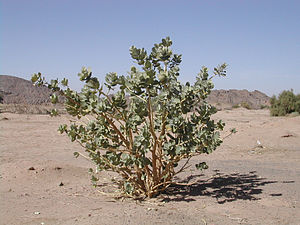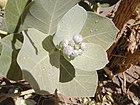Note: This is a project under development. The articles on this wiki are just being initiated and broadly incomplete. You can Help creating new pages.
Difference between revisions of "Calotropis procera"
| Line 29: | Line 29: | ||
==Habit== | ==Habit== | ||
| − | {{Habit|}} | + | {{Habit|Shrub}} |
==Identification== | ==Identification== | ||
| Line 54: | Line 54: | ||
==Commonly seen growing in areas== | ==Commonly seen growing in areas== | ||
| − | {{Commonly seen|}}, {{Commonly seen|}}, {{Commonly seen|}}, {{Commonly seen| | + | {{Commonly seen|Along degraded roadsides}}, {{Commonly seen|Lagoon edges}}, {{Commonly seen|Overgrazed native pastures}}, {{Commonly seen|Sandy soils}}. |
==Photo Gallery== | ==Photo Gallery== | ||
Revision as of 11:46, 8 April 2020
Calotropis procera tree is a large. It grows upto 4 metres tall. The plant can sometimes produce a single bole that is free of branches for up to the first 2.5 metres.
Contents
- 1 Uses
- 2 Parts Used
- 3 Chemical Composition
- 4 Common names
- 5 Properties
- 6 Habit
- 7 Identification
- 8 List of Ayurvedic medicine in which the herb is used
- 9 Where to get the saplings
- 10 Mode of Propagation
- 11 How to plant/cultivate
- 12 Commonly seen growing in areas
- 13 Photo Gallery
- 14 References
- 15 External Links
Uses
Boils, Infected wounds, Skin problems, Asthma, Earache, Stomachache, Arthritis.
Parts Used
Chemical Composition
Common names
| Language | Common name |
|---|---|
| Kannada | |
| Hindi | |
| Malayalam | |
| Tamil | |
| Telugu | |
| Marathi | |
| Gujarathi | |
| Punjabi | |
| Kashmiri | |
| Sanskrit | |
| English |
Properties
Reference: Dravya - Substance, Rasa - Taste, Guna - Qualities, Veerya - Potency, Vipaka - Post-digesion effect, Karma - Pharmacological activity, Prabhava - Therepeutics.
Dravya
Rasa
Guna
Veerya
Vipaka
Karma
Prabhava
Habit
Identification
Leaf
| Kind | Shape | Feature |
|---|---|---|
Flower
| Type | Size | Color and composition | Stamen | More information |
|---|---|---|---|---|
| {{{5}}} |
Fruit
| Type | Size | Mass | Appearance | Seeds | More information |
|---|---|---|---|---|---|
Other features
List of Ayurvedic medicine in which the herb is used
Where to get the saplings
Mode of Propagation
How to plant/cultivate
A plant of the semi-arid tropics and subtropics, it is found growing at elevations from sea level to 1,300 metres. It grows best in areas where the mean annual rainfall is in the range 300 - 400mm.[3]
Commonly seen growing in areas
Along degraded roadsides, Lagoon edges, Overgrazed native pastures, Sandy soils.
Photo Gallery
References
- ↑ ["chemistry"]
- ↑ ["morphology"]
- ↑ Cultivation
External Links
- Ayurvedic Herbs known to be helpful to treat Boils
- Ayurvedic Herbs known to be helpful to treat Infected wounds
- Ayurvedic Herbs known to be helpful to treat Skin problems
- Ayurvedic Herbs known to be helpful to treat Asthma
- Ayurvedic Herbs known to be helpful to treat Earache
- Ayurvedic Herbs known to be helpful to treat Stomachache
- Ayurvedic Herbs known to be helpful to treat Arthritis
- Herbs with Leaves used in medicine
- Habit - Shrub
- Index of Plants which can be propagated by Seeds
- Herbs that are commonly seen in the region of Along degraded roadsides
- Herbs that are commonly seen in the region of Lagoon edges
- Herbs that are commonly seen in the region of Overgrazed native pastures
- Herbs that are commonly seen in the region of Sandy soils
- Herbs
- Pages without herbs images






